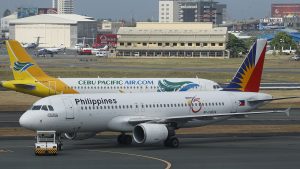Airlines seen posting stronger Q2 revenues on travel demand

By Ashley Erika O. Jose, Reporter
AIRLINE OPERATORS are expected to record higher revenues in the second quarter amid strong travel demand and higher passenger volumes, analysts said, even as recent first-quarter earnings showed mixed performance across carriers.
“We expect airline companies here to post healthy revenue growth in the second quarter on the back of strong travel demand during the summer,” China Bank Capital Corp. Managing Director Juan Paolo E. Colet said in a Viber message.
Mr. Colet said the lower inflation rate and the continued strengthening of the peso against the US dollar are likely to encourage more Filipinos to travel during the dry season and holidays.
Rizal Commercial Banking Corp. Chief Economist Michael L. Ricafort said a stronger peso and easing global crude oil prices are expected to lower operating expenses of local and international carriers.
The peso closed at P55.51 versus the greenback on Friday, appreciating by 12 centavos from P55.63 on Thursday, based on data from the Bankers Association of the Philippines.
“There is still potential for tourism to grow further locally amid improvements in infrastructure such as more modernized airports and mass transport systems for the coming year,” Mr. Ricafort said.
The government is aiming to privatize at least 15 regional airports by 2026 to support its modernization efforts.
PAL INCOME RISESPAL Holdings, Inc. reported a 20.28% year-on-year increase in attributable net income to P4.33 billion in the first quarter from P3.6 billion a year earlier, driven by revenue growth.
The parent firm of flag carrier Philippine Airlines (PAL) posted consolidated revenue of P46.95 billion, up by 2.51% from P45.8 billion in the same period last year.
Passenger revenues rose by 0.45% to P40.53 billion from P40.35 billion; cargo revenues increased by 6.25% to P2.04 billion from P1.92 billion; and ancillary revenues grew by 23.93% to P4.35 billion from P3.51 billion. Revenues from other operations declined by 3.8% to P26.33 million from P27.37 million.
Total expenses climbed by 8.24% to P42.29 billion from P39.07 billion in the same period last year.
“We are greatly encouraged by the support of our valued customers who choose to fly on Philippine Airlines’ global network, and for whom we are investing in progressive product and service improvements, fleet renewal efforts and digital innovations, with safety and reliability as our topmost concerns,” PAL President and Chief Operating Officer Stanley K. Ng said.
PAL carried 4.1 million passengers in the first quarter, up by 5% year on year. Its cargo segment transported 52.6 million kilograms, with over 28,000 flights operated across its international and domestic networks.
The company said higher operating expenses during the period were driven by increased airport charges, third-party contract costs, and depreciation, partially offset by lower fuel expenses.
PAL also said its overall capacity remained steady for the quarter due to ongoing network expansion across both international and local destinations.
CEBU PACIFIC POSTS LOWER INCOMECebu Pacific, operated by Cebu Air, Inc., reported an attributable net income of P465.9 million for the first quarter, down by 79.19% from P2.24 billion in the same period last year, due to rising expenses despite double-digit revenue growth.
Total revenue increased by 20.23% to P30.42 billion from P25.3 billion previously.
Passenger revenue rose by 18.68% to P21.16 billion from P17.83 billion; cargo revenues climbed by 35.2% to P1.69 billion from P1.25 billion; while ancillary revenues increased by 21.7% to P7.57 billion from P6.22 billion.
Total expenses surged by 25.6% to P28.46 billion in the first quarter from P22.66 billion a year ago. Flying operations accounted for the largest share of expenses, reaching P10.78 billion, up by 15.42% from P9.34 billion last year, according to the airline’s financial statement.
“We remain optimistic on our financial outlook. Underlying demand for affordable air travel remains strong, and we’ve made earlier strategic investments to ensure resilient operations. Leveraging on these existing assets, CEB remains well positioned for sustainable growth, and improving profitability,” Cebu Pacific Chief Financial Officer Mark Julius V. Cezar said.
Repairs and maintenance expenses rose by 66.67% to P5.9 billion from P3.54 billion, the financial statement showed.
Cebu Pacific flew seven million passengers in the first quarter, up by 26% year on year.
As of end-March, the airline operated a fleet of 99 aircraft across 63 destinations and 127 routes, with more than 3,200 weekly flights.
Over the past 12 months, the airline took delivery of 15 aircraft and 13 spare engines to support capacity growth, which it said contributed to higher fleet and financing costs for the period.




